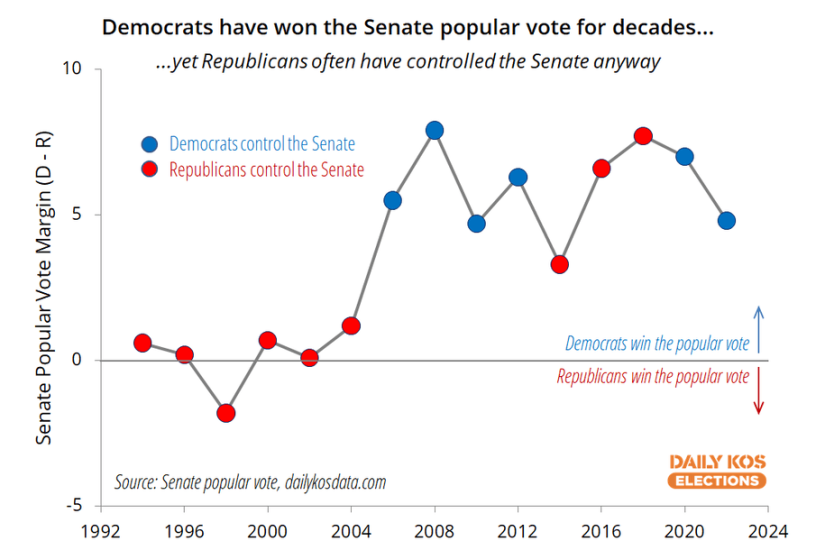Even though Democrats retained the Senate—and expanded their majority—in 2022, the results nonetheless marked the continuation of an unwelcome trend: Our new data shows that Senate Republicans last won more votes or represented more Americans than Democrats in 1998, but the GOP has controlled the upper chamber fully half the time since then nonetheless.
The graph at the top of this post visualizes this phenomenon, illustrating just how glaring this disparity is. It also underscores a deep problem for American democracy that's further exacerbated by the Electoral College and gerrymandering in the House, both of which likewise enable one of our two parties to win power despite getting fewer votes nationwide than the other.
Together, these three institutions that form two of the branches of our federal government are set up to regularly allow minority rule—and to allow a minority to further entrench itself in power. Rectifying this imbalance will require creative thinking and determined effort on the part of Democrats, since it's Republicans who have benefited from the current state of affairs in recent decades and bitterly oppose any reform.
Ever since 2000, Republicans have repeatedly won control of the Senate despite losing the popular vote; at the same time, they've also represented states with a minority of the U.S. population. This was the case from 2000 through 2006 and again from 2014 through 2020, covering six of the last 12 federal elections. (To determine the Senate popular vote in a given year, we combined the most recent results for all 100 seats; you can see our data below and find a detailed accounting of our methodology here.)

That asymmetry has only grown more extreme. As illustrated by the graph below, the 51 members of the Democratic caucus today represent 58% of the country's population compared to only 42% for the chamber’s 49 Republicans; that's an increase from two years ago, when the population gap was already a considerable 57-43. That means Democrats continue to have tens of millions more constituents while controlling just two more seats, and they've likewise won millions more votes than Republicans across the three most recent election cycles that have elected the current members of the Senate.

Republican minority rule in the Senate just this century alone has already had far-reaching consequences, particularly through its impact on the judiciary. Five of the six conservative justices on the Supreme Court—all of them except for Clarence Thomas—were confirmed by Senates where the GOP majority was elected with less popular support than Democrats. Three of those justices were even appointed by a president who himself had lost the popular vote.
